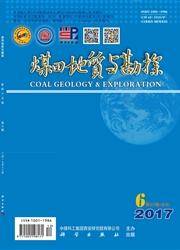

 中文摘要:
中文摘要:
针对煤层气钻井过程中钻井液的侵入可能给煤岩储层造成的损害,选用宁武盆地9号煤和现场用钻井液为研究对象,开展了煤样钻井液动–静态损害评价、毛细管自吸、应力敏感性评价等实验.钻井液动–静态损害评价表明,钻井液滤液损害是造成煤层渗透率下降的主要原因;与地层水相比,煤样对钻井液的自吸能力强且吸附滞留严重,导致液相返排率偏低;钻井液作用后弱化煤样力学性质强化了煤样应力敏感性.结合水敏、碱敏、润湿性评价和扫描电镜分析结果,指出钻井液作用后煤岩裂隙堵塞、润湿性差异和钻井液吸附是钻井液造成煤层损害的主要因素.
 英文摘要:
英文摘要:
Aiming at reservoir damage caused by drilling fluid invasion during CBM drilling, the paper, byselecting seam No.9 in Ningwu basin and drilling fluid used in site as research object, conducted evaluation ofdynamic- static damage of coal samples caused by drilling fluid, capillary imbibition and stress sensitivity.Dynamic-static damage evaluation shows that filtrate damage of drilling fluid is the main cause for reduction ofpermeability in coal seam, coal imbibitions ability is strong and adsorption retention is serious for drilling fluidwhen compared with formation water, which lead to the low liquid phase flow-back, after being reacted with thedrilling fluid, coal samples has weakened mechanical properties and strengthened stress sensitivity. In combinationwith the analysis results of water sensitivity, alkali sensitivity, wettability evaluation and scanning electronmicroscopy (SEM), it is pointed out that fracture blocking, wettability difference and drilling fluid adsorption ofcoal are the main factors of seam damage caused by drilling fluid.
 同期刊论文项目
同期刊论文项目
 同项目期刊论文
同项目期刊论文
 期刊信息
期刊信息
